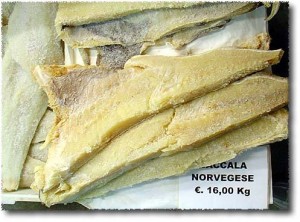June 15th, 2012 § § permalink
Spent a delightful hour chatting on the phone with Miranda Wolfe, daughter of the late Bernard Wolfe, an extraordinary writer who wrote just about everything: novels, short stories, journalism, ghosted Broadway columns, television, screen plays and customized pornography which he produced for one reader — an Oklahoma oil zillionaire (Wolfe was in good company in this customized porn business as the eccentric Oklahoman also hired, amongst others, Henry Miller, Anais Nin and Gene Fowler. What they all had in common was a need for quick cash). Sorry. Don’t want to emphasize the pornography. This was just a miniscule portion of Wolfe’s output (and he found it distasteful). Make haste and read BW’s works.. A good start would be Really The Blues which he wrote with jazz musician Mezz Mezzrow. (This book heavily influenced influenced the Beat Generation of writers — Kerouac, Ginsberg, etc.. For a treat, listen to some of the music forgotten Mezzrow made with Sidney Bechet. Check it here!). The Late Risers defined the cool Broadway hipsters of many decades ago. The Great Prince Died is a historical novel based on the Mexican exile of the great Russian revolutionary and anti-Stalinist, Leon Trotsky. Later, the title was changed to Trotsky Dead. At one time, Wolfe was bodyguard/secretary for Trotsky (he wasn’t present when Trotsky was pickaxed to death by a Stalin assassin).
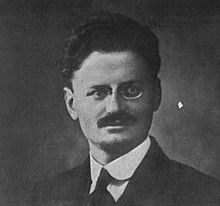
BW also wrote Limbo, a prescient sci-fi novel.
Wolfe had quiet sartorial elegance and a well stocked mind. Unlike many writers, he excelled at both talking and listening. HG enjoyed some memorable dining with Wolfe. Bernie’s favorite restaurant (and HG’s) was Fornos. a happy Spanish place that flourished on West 52nd Street many years ago (here, BW was formally addressed as “Senor Lupo”). The excellent food was preceded by classic Margaritas and ended with Banana Daquiris. Very hard to leave sober. Bernie liked the Oak Room of the Algonquin hotel where he would compose his meals carefully and creatively after some knowledgeable consultation with the waiter and captain. Alas, the composition of a meal is a skill that has virtually disappeared in New York (but, not in Paris).
In the 50s and early 60s Russian and Iranian caviar was cheap (If you listen closely you may hear the sound of teardrops falling on HG’s keyboard). HG recalls a caviar feast HG (and his ex-wife) hosted at their town house apartment in the Gramercy Park neighborhood. Some two pounds of Beluga (from Caviarteria) were devoured with thin, buttered white toast and washed down with abundant, icy Polish Wyborowa Vodka. In addition to Bernie, the other guests were screenwriter/painter/novelist Fred Segal and his then wife, Sandra. The caviar was followed by cognac and Upmann Brevas cigars, Maduro leaf. Not exactly an homage to healthy living. HG and his ex-wife survive. The others, sadly, are gone. Miranda Wolfe is busy working on Bernie’s voluminous and distinguished literary legacy. Hopefully, many gems will be reissued. Pornography has been described (by the French, of course) as books read with one hand. HG will be reading the reissued Wolfe works with one hand. The other will be clutching a glass of ultra chilled Polish vodka.

June 13th, 2012 § § permalink
In 1930s New York, many apartment buildings, shops (and restaurants) were designed in a streamlined, modernist style — a kind of Art Deco for the masses. While true Art Deco (which reached its height in Paris of the 20s and 30s) was very elegant and seriously luxurious, the young American designers who piggy backed on the Art Deco style were a bit more egalitarian. Their best efforts, in terms of major structures, can be seen in the apartment houses that line the Grand Concourse in the Bronx and the glorious hotels of Miami’s South Beach. Smaller design gems were the chain bakeries that flourished in all of New York’s neighborhoods. The aim of all the “streamlining” was to give shoppers an optimistic lift in the gloom of the Great Depression. The “streamlined” bakeries were Cushman’s and Hanscom’s. The famed industrial designer Raymond M. Loewy designed Cushman’s and Horace Ginsbern designed Hanscom’s. (Ginsbern, then fairly young, later became one of New York’s most prominent apartment house architects. Ginsbern was born in 1893 and died in 1969. Scores of his buildings exist in Manhattan’s Upper East Side).
The architect Robert A.M. Stern has commented on the Loewy and Ginsbern bakery designs: “They brought a relatively high level of International Style Modernism into virtually every New York neighborhood.”
Cushman’s had white porcelain facades; nautical, oval windows and the name was spelled out in a curving, gold script. Hanscom’s had apple green porcelain facades and the name was formed with blocky, super- modern letters. Stern described the entire architectual composition as “Constructivist.”
In the Bronx you had Jewish Bakeries and Italian bakeries. The Jewish bakeries had elaborate butter cream cakes and, of course, bagels, bialys, rye and pumpernickel bread, etc. These were jammed on Sunday mornings with Dads buying bread-stuffs for brunch (The casual tweed and camel hair jackets many of them wore were known as “bagel coats”). The Italian bakeries, in neighborhoods like Belmont, had, of course, sublime bread, delicious cannolis, pignoli cookies and other Italian specialties. There was plenty of cross pollination. Jews liked the corn muffins and cookies at Cushman’s and Hanscom’s (which were generalized as goyish bakeries) and there were plenty of bagel and rye bread fanciers among the non-Jewish population. And, of course, everyone loved their Italian baked goods. Some Jewish bakery survivors in Manhattan are Moishe’s Bakery on 2nd Ave, Streit’s, which bakes and sells matzos, macaroons, kichel and other stuff from a 47,000 foot factory on Rivington Street and Kossar’s which bakes and sells bialys and other traditional good stuff from a location near the Essex Street Market. SJ sent HG a batch of Kossar’s products a few months ago producing moans of delight. The eminent food writer, Mimi Sheraton, a woman who knows Jewish food, says a Kossar’s bialy is the only true bialy baked in the United States. HG agrees.
Interestingly, HG’s Mom never called a bialy by that shortened name. She paid appropriate homage by calling it a Bialyosteker Kuchen.

June 10th, 2012 § § permalink
During the 60s (and into the 70s and 80s) HG and BSK were known to puff some mind altering substances. And, this habit led to a desire for sweet baked goods. Fortunately, Manhattan was well supplied with wonderful family owned bakeries (many staffed by European immigrants who brought their pastry skills to the New World). On the West Side was the Eclair Bakery and Cafe on W. 72nd Street and a great bakery (name forgotten) on the southeast corner of Broadway and 79th Street. On the East Side was Mrs. Herbst’s Strudel and Rigo Hungarian. William Greenberg Jr. Desserts was (and remains) on Madison Avenue and purveyed (and still purveys!) sticky buns from heaven. A cheap treat for potheads was the caramel popcorn aptly named Screaming Yellow Zonkers. Screaming Yellow Zonkers were, in fact, one of the first mainstream products that absolutely focused on the Pot Head as consumer and employed psychedelic illustration, absurdist copy and, of course, sweet-salty crunchy goodness to lure Pot Heads. (They succeeded in this endeavor. HG noted, while in the queue at the Ziegfeld Theater to see Stanley Kubrick’s mind bending ” 2001: A Space Odyssey”, that everyone was carrying Screaming Yellow Zonkers or enticing blue and white boxes of Entenmann’s chocolate donuts). Ah, those were sweet times, indeed.

June 8th, 2012 § § permalink
Sutter’s Bakery. Just say these two words to old New Yorkers and watch their happy faces as they rummage through delicious memories. The Manhattan location of Sutter’s Bakery was at Greenwich Avenue near Sixth Avenue. Next door was the later demolished Women’s House of Detention (Ladies of the night were locked up there and had animated conversations through the bars with their business agents gathered on the sidewalk below). Sutter’s had the best pecan ring, Danish pastries, cookies, croissants, brioche, etc. It was a big place with outstanding variety. (There were equally great Sutter’s on the Grand Concourse in The Bronx and Flatbush Avenue in Brooklyn). HG and BSK recall many happy, Winter Sunday mornings during their early married days. The Sunday Times. Radical radio station WBAI broadcasting subversive joy. Sutter’s gently warmed croissants and brioche. Sweet butter. English marmalade. Steaming mugs of Droste’s cocoa. Snow might have been pelting down W. 67th Street and the wind might have been whistling a frigid tune. But, all was toasty joy in HG and BSK’s rent controlled paradise.
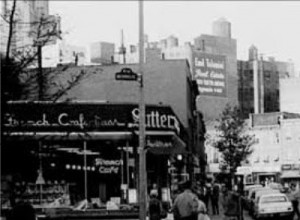
June 5th, 2012 § § permalink
The answer to this question is: Yes and No. If you are talking about food and the price/quality ratio, New York tops Paris. Also, Paris is, for the the most part, a one trick pony. True, many of Paris’ most edgy restaurants and 3 Star Shrines have increased the use of Asian spices and cooking techniques to touch on a type of fusion cuisine; but overall, what you get in the majority of Paris Restaurants is French food. With the exception of Moroccan, other ethnic cuisines are dumbed down to suit conservative Parisian tastes. Compare that to New York which has three distinct Chinatowns each with an enormous amount of eating spots. There are whole neighborhoods in Queens (and in other boroughs) devoted to ethnic dining: Korean, Vietnamese, Indian, Greek, Italian, Mexican, Argentine and Colombian, Russian, Jamaican — and much more. And those are just the outer boroughs. Within Manhattan itself, you are able to go on a veritable world cuisine tour in just a 4 block radius. And, yes, great Jewish pastrami still lives in, alas, fewer and fewer places. Makes Paris seem very provincial. Small town. In addition, New York has steak houses like Peter Luger’s and Spark’s that are true carnivore heavens.
But, Paris still has that indefinable something, Call it charm. Call it elan. Call it sparkle. Whatever. HG is thinking about late night meals at the art deco brasserie Le Vaudeville which seemingly hums with joy and the promise of good times. Brass. Aged, cigarette-smoke stained marble. Perfect lighting. Or, dinner at the brasserie Le Stella on posh Rue Victor Hugo. Low voices. Women who know how to tie scarves. Men in well cut tweeds or blazers. Soaring towers of fruits de mer. Or, the died-and-gone-to-heaven grilled sole drenched in the best butter at Le Dome. Or, the intimacy, warmth and sheer sexiness of many small bistros serving unassuming food. There was a left bank place called Balzar where the clientele and atmosphere were so diverting that the so-so food was forgiven. (Taken over by a chain some years ago, HG does not know if the place still pleases). Other Paris pluses: Steak tartare (always bad in New York); Belon oysters; blood sausage (boudin noir); tete de veau and offal. (An exception: Paris tripe doesn’t compare to New Mexico menudo as served by places like El Parasol near Santa Fe).
Probably, the most beguiling quality about Paris restaurants is their sheer professionalism. No surprise. The restaurant, as we know it, was invented in Paris. But, if your interest is in variety and getting a dining bang for your buck, New York is incomparable. Yes, “What street compares to Mott Street in July, sweet pushcarts gently gliding by?”. But, an after dinner walk in Paris with the Eiffel Tower sparkling in the distance is nothing to sneer at.
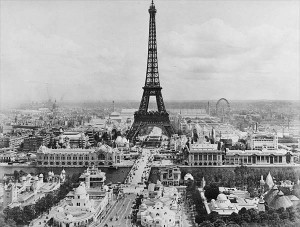
May 27th, 2012 § § permalink
That’s a question HG often puts to himself. HG is referring to drinking habits in the 50s and for most of the 60s. In those halcyon days, HG lunched daily in Manhattan restaurants with journalists, pals or HG’s public relations clients. Typical lunch at the Blue Ribbon, very good German restaurant on W. 45th (convenient for journalists from Times, Herald-Tribune, Newsweek and Business Week): Two dry martinis with Rollmops Appetizer (Bismarck herring rolled around a dill pickle); steak tartare or bratwurst or Kassler Rippchen (smoked pork chop) washed down with two large, dark beers. Cognac and a cup of black coffee to finish. At Russian Tea Room, HG drank chilled vodka throughout a lunch of Eggplant Oriental, Borscht with Pirozhki (flaky meat pastries) or Siberian Pelmeni (tiny Russian ravioli in a rich chicken consomme infused with generous quantities of chopped dill, sour cream and strong mustard). Wine, of course, accompanied the food at Sardi’s, Four Seasons, Gino’s. Patsy’s, Charles, Christ Cella, etc. But, two martinis always jump started the lunch. After lunch, an energetic HG was back at work. Focused. Productive. HG was not alone. Men (and women) drank cocktails at lunch — Martinis, Manhattans or Whiskey Sours. How could we function with so much lunchtime booze? We did. And, it was fun.

May 23rd, 2012 § § permalink
HG flexed his dining muscles in the 1950’s when New York restaurants were very inexpensive and contained many delights for the adventurous fledgling gourmand. An HG favorite was a warm and friendly French bistro, Fleur de Lis, located at 141 W. 69th Street. It was here that HG delved into the wonderful world of innards prepared in traditional French style. Brains in black butter. Tripe in the style of Caen. Roast kidneys and kidneys in mustard sauce. Tete de Veau (all the little goodies plucked from the head of a cow and served in a thick vinaigrette). Sweetbreads in a lush red wine sauce.These dishes ranged in price from $1.35 to $1.60. Yes, you read it right. A generous plate of Sole Meuniere was $1.15 as was a heaping bowl of mussels (accompanied by pomme frites). The most expensive dish on the menu was a one and-a-half pound lobster for $3.00. HG liked to start the meal with Saucisson and warm potato salad ($.35) or pickled herring ($.35) or a copious crabmeat cocktail ($.50). Red and white wine was served by the glass ($.25). A nice aperitif was dry, chilled sherry ($.25). The cheese selection was composed of Camembert, goat, Port du Salut and blue cheese. Served generously and at the right temperature ($.25 each) Went nicely with port ($.25 a glass). Desserts included creme caramel and chocolate mousse (each $.35). All of these prices are from the Nov. 1955 Fleur de Lis menu.
At that time, HG was a highly paid journalist ($175 a week) who supplemented his pay by moonlighting as a press agent. When HG and BSK wed in 1963 they lived at 27 W. 67th Street in a dramatic artist’s studio one bedroom apartment (Rent: $140 a month). HG had left journalism for the more lucrative field of press agentry. The nearby Fleur de Lis was still going strong and the newlyweds ate there often. Prices had risen, of course, but the bistro remained quite affordable. On their wedding night (a sultry and stuffy July night) HG and BSK dined there with family members. HG had escargots (lots of garlic), mussels (lots of garlic), rare tenderloin steak (lots of garlic). Later that night, in their non-air conditioned bedroom, BSK contemplated HG, her sleep companion, her husband, her life-long partner and what she saw was a hairy man with fragrant garlic oozing from every sweaty pore. It crossed BSK’s mind then (and probably not the only time during the ensuing 49 years) that she had made a dreadful mistake.

May 18th, 2012 § § permalink
Anyone remember these coffee and fast food counter restaurants that once flourished in New York? There were about 80 locations before the chain closed in the 1970s. The coffee brand still flourishes and is sold in supermarkets everywhere. At Chock Full you got a very good cream cheese sandwich on nutted date bread (a favorite of female office workers), whole wheat doughnuts (best doughnut ever, in HG’s opinion), good frankfurters and orange drink. Splendid coffee, of course. Very, very cheap. Swift service by unsmiling, sullen, very angry African-American women. William Black, who owned the chain, tried to make morale better by hiring baseball great Jackie Robinson as Director of Personnel in 1957. Didn’t make any difference. It was still Service-With-A-Sneer. All food at Chock Full was handled with tongs (for alleged hygienic benefits) and advertised “Food Untouched By Human Hands.” The chain got its unusual name from Black’s retail start: a little shelled nut store he opened in 1926. It grew to a chain of 18. Black, a smart (and eccentric) guy, met the challenge of the Great Depression by converting the nut shops to lunch counters in 1931. The signature cream cheese sandwich and a cup of coffee was five cents. Big success. Black married a cabaret singer named Page Morton. For many decades New York radio and TV commercials featured the rather mature, slightly off-key and quite wavery-voiced Ms. Morton singing the Chock Full O’ Nuts coffee jingle: “Chock Full O’ Nuts — That Heavenly coffee.” The persistence of this ad and her suspect talent made it obvious that Black really loved his wife.
After many corporate shifts and buy outs, Chock Full (now owned by an Italian coffee giant), decided, in 2010, to open a Chock Full O’ Nuts restaurant, serving some of the old favorites, on E. 23 Street in the Flatiron District. Very extensive menu. Very slow service. A mixed reception from diners. The cream cheese sandwich costs $4.95.

May 16th, 2012 § § permalink
Gone from the streets of the ever more trendy Lower East Side of Manhattan are the choppers. Permit HG to explain. HG does nor refer to people with cleavers. The “ch” in HG’s “choppers” is pronounced with a guttural, Yiddish “ch” as in “challah.” In Yiddish the word chop means “grab.” And, that’s what a chopper did. He grabbed you. When little HG accompanied his father on various Lower East Side errands, choppers were stationed outside of men’s clothing stores on East Broadway and Division Streets. They would grab the arm of HG’s father and try to drag him into a store. Meanwhile they offered a sales pitch in heavily accented English: “Come inside. Bargains. The finest materials. Beautiful suits, coats. Latest styles. Take a look. Prices you won’t believe. No harm in looking.” The chopper had a grip like an iron vise. It took real strength (possessed by HG’s father) to extricate oneself from a dedicated chopper.
All of this took place many, many decades ago in a simpler New York. Now geniuses like Wylie Dufresne turn out imaginative food in chic Lower East Side restaurants. Nary a knish or “chopper’ in sight.
SJ here. Allow me to make a brief interjection. True, the Lower East Side has transformed into a hipster playground of trendy bars, cafes, etc. But, like a ghost sign that bleeds through faded paint jobs, elements of the old Lower East Side are still with us. Orchard Street, while gussied up beyond recognition, still houses of number of old clothing stores and, surprise, surprise, an honest to god chopper. Yes, I was recently stopped in my tracks — the grip was that strong — by a middle aged Hasid who said, “Young man, you look like a fellow who could use a nice suit. We have suits, so good, so cheap, come inside…” A relic of the old days, the chopper still has the stuff…And when it comes to knishes!!! We have the best still in operation!!! Yes Yonah Schimmel Knishes is open right on Houston Street and serving up a delicious Knish — get the Kasha!!!
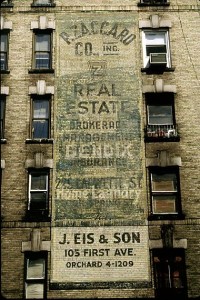
May 11th, 2012 § § permalink
Yes, salt cod is spelled in different ways in Portugal, Italy, Spain, Brazil, France and other countries where it is enjoyed and appreciated. It needs a good soaking in many changes of water before it can be cooked but that’s time well spent because it is a staple of many wonderful dishes. An HG favorite is Brandade, a puree of salt cod, potatoes, sweet cream and garlic — lots of garlic. HG eats it with slices of garlic rubbed, toasted sourdough bread. Cold Muscadet or Macon-Village Chardonnay is a pleasant accompaniment. HG likes the Brandade at both Balthazar, the busy New York brasserie and Jonathan Waxman’s Barbuto Restaurant in Greenwich Village.
Salt cod has an affinity for garlic. The Provence feast of poached salt cod and vegetables (cooked and raw) is served with an abundance of aioli, a garlic enriched mayonnaise. HG is looking forward this weekend to BSK’s Basque salt cod (cooked with olive oil, white wine, tomatoes, capers, parsley and, of course, garlic). BSK will serve it with her smashed potatoes gilded with Sicilian olive oil. And, to make sure that vampires are kept at bay, HG will make plenty of aioli (HG will add some cayenne for a bit of a bite).
While no garlic was served in the dish, SJ once made HG salivate with a description of an improvised feast in the Blue Mountains of Jamaica consisting of chunks of sat cod and yam roasted over an open fire with a hefty dose of margarine. And in Rome’s Campo Di Fiori there is a busy, little joint that apparently serves salt cod fritters to die for. HG bets there is garlic in those fritters.
In the Italian-Irish-Jewish Bronx nabe where HG was reared, lengths of dried salt cod were displayed like cord wood in every Italian food store. Now you can find it in cute little wooden boxes at the fish counters of supermarkets. Progress: The wooden box salt cod has less bones.
